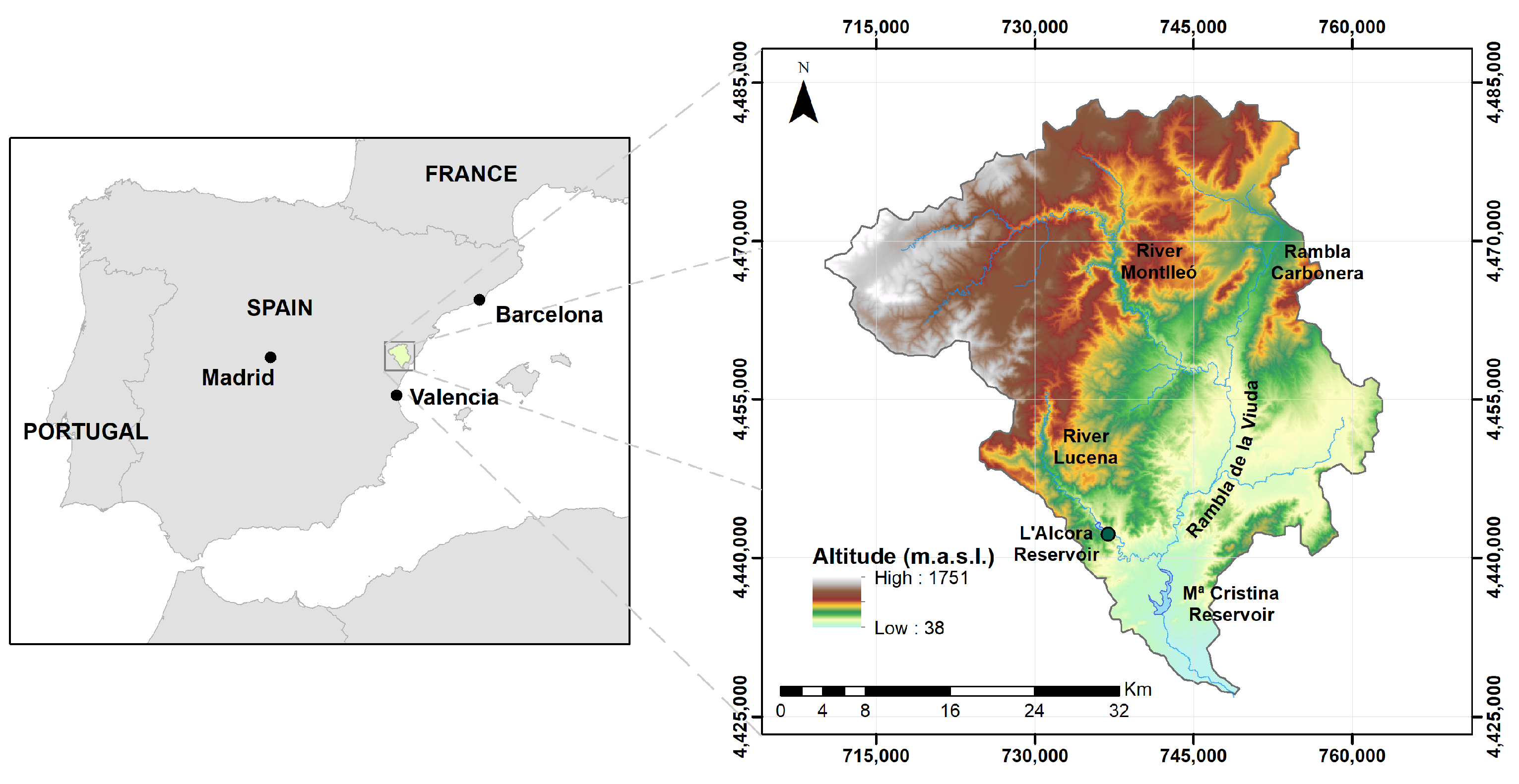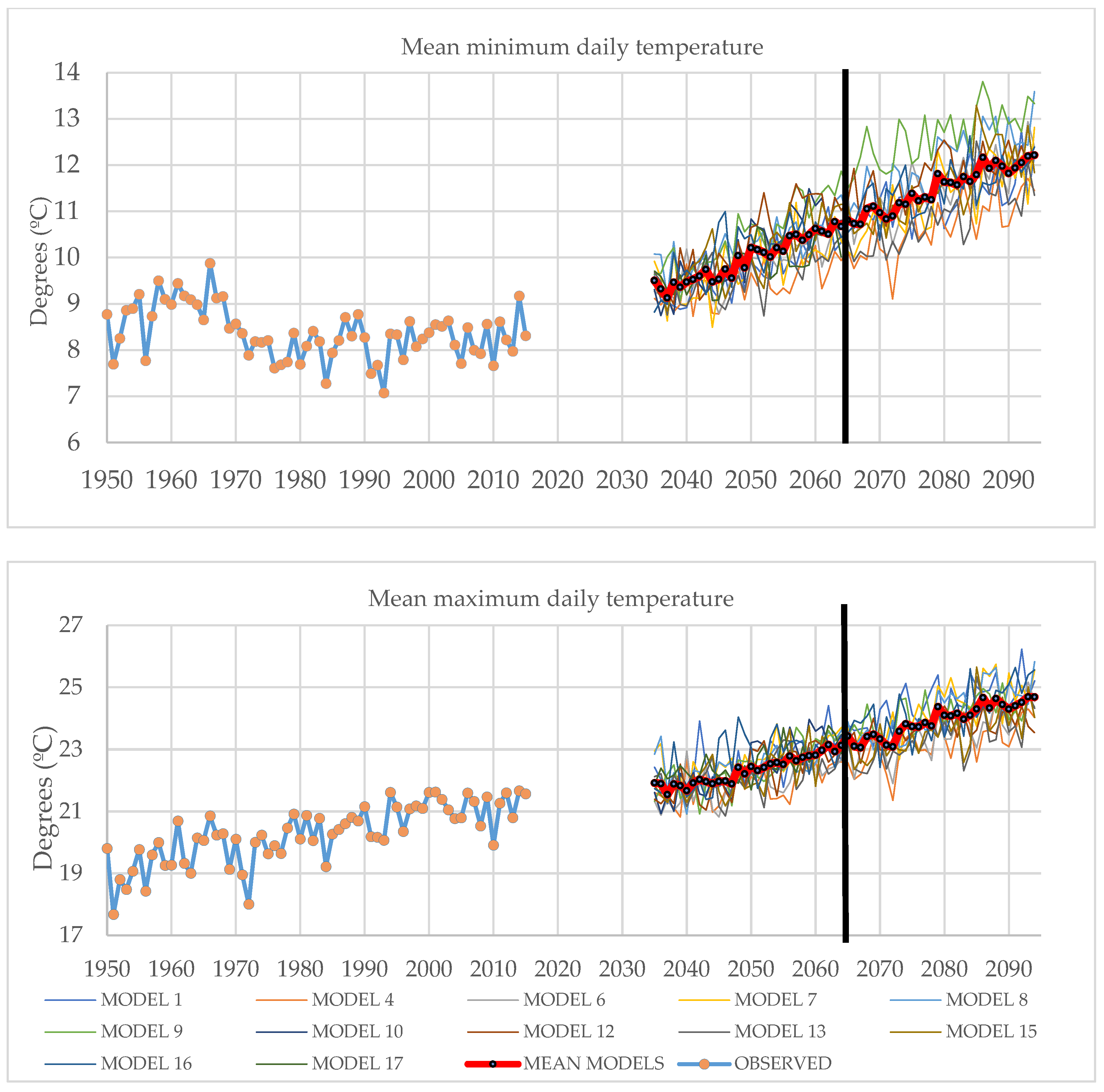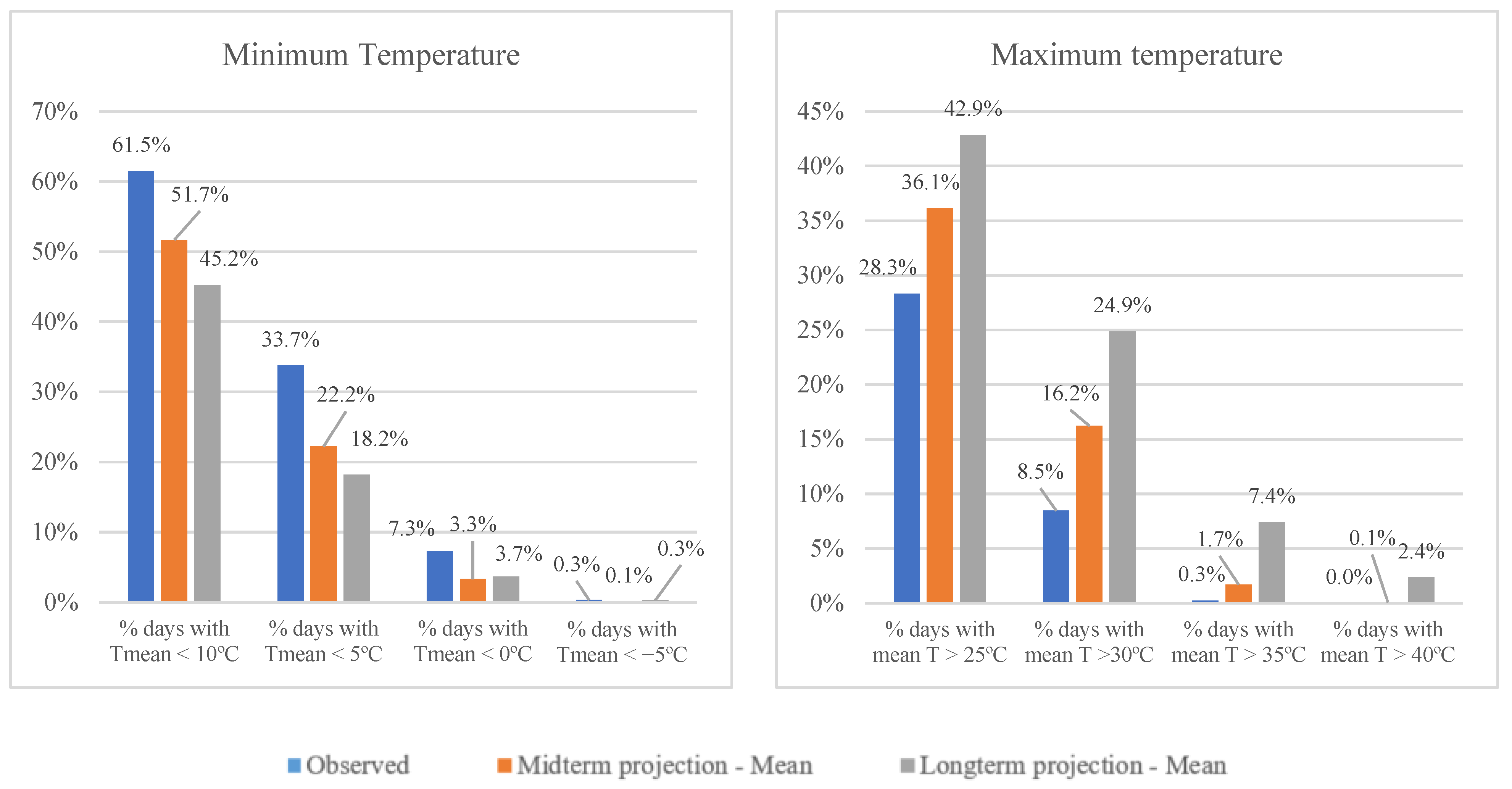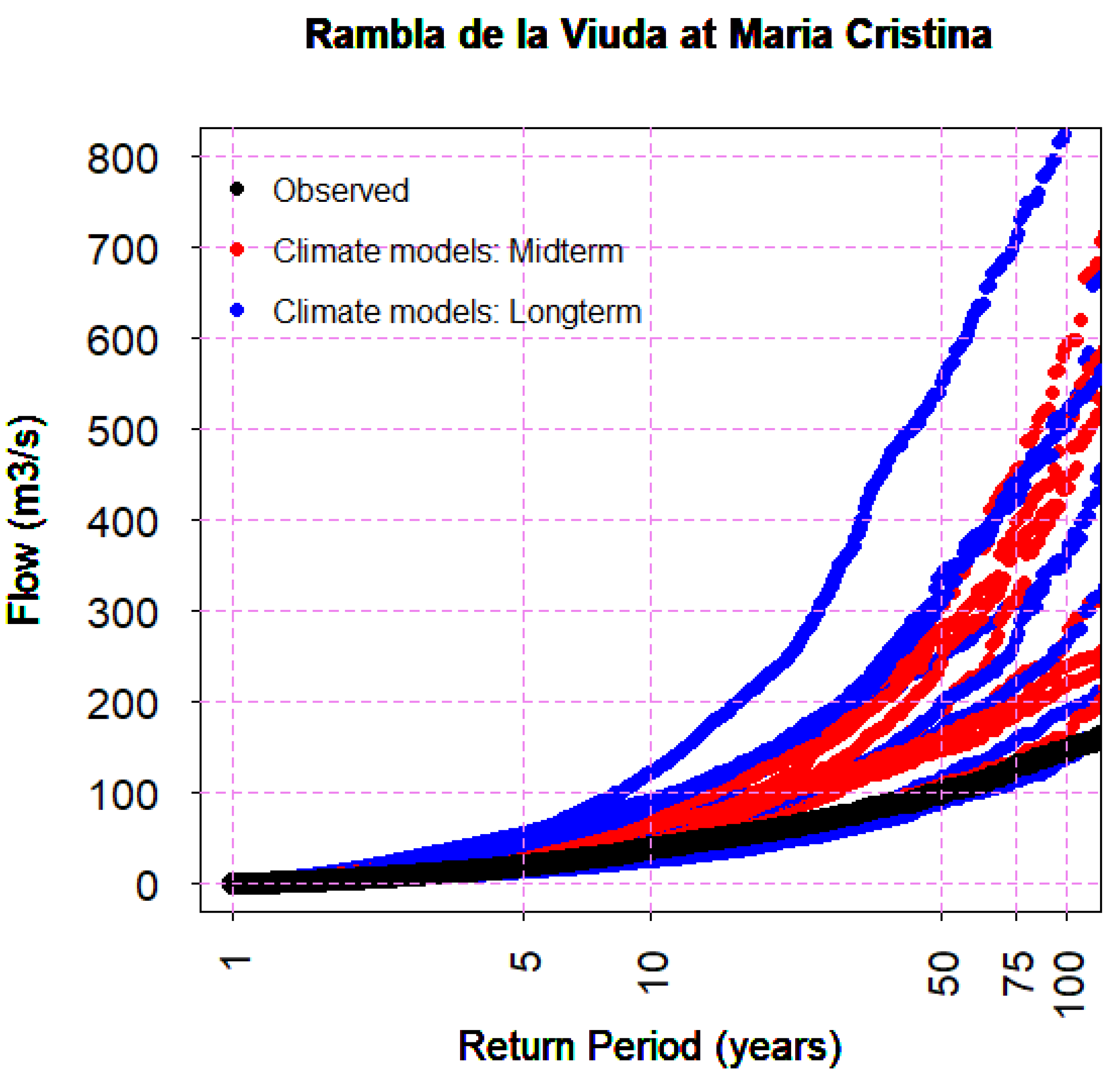On the Use of Weather Generators for the Estimation of Low-Frequency Floods under a Changing Climate
Abstract
:1. Introduction
2. Case Study
2.1. Study Area
2.2. Hydrometeorological Information
3. Methodology
3.1. Bias Correction of Climate Series
3.2. Regional Study of Maximum Daily Precipitation
3.3. Weather Generator: GWEX
3.4. Ecohydrological Model: TETIS
4. Results
4.1. Temperatures
4.2. Precipitation
4.3. Discharges
5. Discussion
6. Conclusions
Author Contributions
Funding
Data Availability Statement
Acknowledgments
Conflicts of Interest
References
- Kidson, R.; Richards, K.S. Flood frequency analysis: Assumptions and alternatives. Prog. Phys. Geogr. 2005, 29, 392–410. [Google Scholar] [CrossRef]
- Lisø, K.R.; Kvande, T.; Time, B. Climate Adaptation Framework for Moisture-resilient Buildings in Norway. Energy Procedia 2017, 132, 628–633. [Google Scholar] [CrossRef]
- Metzger, A.; Marra, F.; Smith, J.A.; Morin, E. Flood frequency estimation and uncertainty in arid/semi-arid regions. J. Hydrol. 2020, 590, 125254. [Google Scholar] [CrossRef]
- Soltani, A.; Hoogenboom, G. Minimum data requirements for parameter estimation of stochastic weather generators. Clim. Res. 2003, 25, 109–119. [Google Scholar] [CrossRef]
- Merz, R.; Blöschl, G. Process controls on the statistical flood moments—A data based analysis. Hydrol. Process. 2009, 23, 675–696. [Google Scholar] [CrossRef]
- Merz, R.; Blöschl, G. Flood frequency hydrology: 2. Combining data evidence. Water Resour. Res. 2008, 44, W08433. [Google Scholar] [CrossRef]
- Benito, G.; Sanchez-Moya, Y.; Medialdea, A.; Barriendos, M.; Calle, M.; Rico, M.; Sopeña, A.; Machado, M.J. Extreme Floods in Small Mediterranean Catchments: Long-Term Response to Climate Variability and Change. Water 2020, 12, 1008. [Google Scholar] [CrossRef]
- Evin, G.; Favre, A.C.; Hingray, B. Stochastic generation of multi-site daily precipitation focusing on extreme events. Hydrol. Earth Syst. Sci. 2018, 22, 655–672. [Google Scholar] [CrossRef]
- Beneyto, C.; Aranda, J.Á.; Benito, G.; Francés, F. New approach to estimate extreme flooding using continuous synthetic simulation supported by regional precipitation and non-systematic flood data. Water 2020, 12, 3174. [Google Scholar] [CrossRef]
- Alfieri, L.; Bisselink, B.; Dottori, F.; Naumann, G.; de Roo, A.; Salamon, P.; Wyser, K.; Feyen, L. Global projections of river flood risk in a warmer world. Earth’s Future 2017, 5, 171–182. [Google Scholar] [CrossRef]
- Paprotny, D.; Morales-Nápoles, O. Estimating extreme river discharges in Europe through a Bayesian network. Hydrol. Earth Syst. Sci. 2017, 21, 2615–2636. [Google Scholar] [CrossRef]
- IPCC. IPCC AR6 WGII Sixth Assessment Report; IPCC: Geneva, Switzerland, 2022. [Google Scholar]
- Roudier, P.; Andersson, J.C.M.; Donnelly, C.; Feyen, L.; Greuell, W.; Ludwig, F. Projections of future floods and hydrological droughts in Europe under a +2°C global warming. Clim. Chang. 2016, 135, 341–355. [Google Scholar] [CrossRef]
- Soriano, E.; Mediero, L.; Garijo, C. Quantification of Expected Changes in Peak Flow Quantiles in Climate Change by Combining Continuous Hydrological Modelling with the Modified Curve Number Method. Water Resour. Manag. 2020, 34, 4381–4397. [Google Scholar] [CrossRef]
- Yin, J.; Guo, S.; He, S.; Guo, J.; Hong, X.; Liu, Z. A copula-based analysis of projected climate changes to bivariate flood quantiles. J. Hydrol. 2018, 566, 23–42. [Google Scholar] [CrossRef]
- Jain, S. Downscaling Methods in Climate Change Studies. Nihroorkee.Gov.in 2014, 1–18. [Google Scholar]
- Hay, L.E.; Wilby, R.L.; Leavesley, G.H. A comparison of delta change and downscaled GCM scenarios for three mountainous basins in the United States. J. Am. Water Resour. Assoc. 2000, 36, 387–397. [Google Scholar] [CrossRef]
- Gleick, P.H. Methods for evaluating the regional hydrologic impacts of global climatic changes. J. Hydrol. 1986, 88, 97–116. [Google Scholar] [CrossRef]
- Hay, L.E.; Clark, M.P. Use of statistically and dynamically downscaled atmospheric model output for hydrologic simulations in three mountainous basins in the western United States. J. Hydrol. 2003, 282, 56–75. [Google Scholar] [CrossRef]
- Maraun, D.; Wetterhall, F.; Ireson, A.M.; Chandler, R.E.; Kendon, E.J.; Widmann, M.; Brienen, S.; Rust, H.W.; Sauter, T.; Themel, M.; et al. Precipitation downscaling under climate change: Recent developments to bridge the gap between dynamical models and the end user. Rev. Geophys. 2010, 48, RG3003. [Google Scholar] [CrossRef]
- Pierce, D.W.; Cayan, D.R.; Maurer, E.P.; Abatzoglou, J.T.; Hegewisch, K.C. Improved bias correction techniques for hydrological simulations of climate change. J. Hydrometeorol. 2015, 16, 2421–2442. [Google Scholar] [CrossRef]
- Mehrotra, R.; Sharma, A. A multivariate quantile-matching bias correction approach with auto- and cross-dependence across multiple time scales: Implications for downscaling. J. Clim. 2016, 29, 3519–3539. [Google Scholar] [CrossRef]
- Themeßl, M.J.; Gobiet, A.; Heinrich, G. Empirical-statistical downscaling and error correction of regional climate models and its impact on the climate change signal. Clim. Chang. 2011, 112, 449–468. [Google Scholar] [CrossRef]
- Maraun, D. Bias Correcting Climate Change Simulations—A Critical Review. Curr. Clim. Chang. Rep. 2016, 2, 211–220. [Google Scholar] [CrossRef]
- Beranová, R.; Kyselý, J.; Hanel, M. Characteristics of sub-daily precipitation extremes in observed data and regional climate model simulations. Theor. Appl. Climatol. 2018, 132, 515–527. [Google Scholar] [CrossRef]
- Faghih, M.; Brissette, F.; Sabeti, P. Impact of correcting sub-daily climate model biases for hydrological studies. Hydrol. Earth Syst. Sci. 2022, 26, 1545–1563. [Google Scholar] [CrossRef]
- Requena, A.I.; Nguyen, T.H.; Burn, D.H.; Coulibaly, P.; Nguyen, V.T. Van A temporal downscaling approach for sub-daily gridded extreme rainfall intensity estimation under climate change. J. Hydrol. Reg. Stud. 2021, 35, 100811. [Google Scholar] [CrossRef]
- World Meteorological Organization. WMO Guidelines on the Calculation of Climate Normals; WMO-No. 1203; World Meteorological Organization: Geneva, Switzerland, 2017; p. 29. [Google Scholar]
- Beneyto, C.; Ángel, J.; Francés, F. Exploring the uncertainty of Weather Generators’ extreme estimates in different practical available information scenarios. Hydrol. Sci. J. 2023, 68, 1203–1212. [Google Scholar] [CrossRef]
- Beneyto, C.; Vignes, G.; Aranda, J.Á.; Francés, F. Sample Uncertainty Analysis of Daily Flood Quantiles Using a. Water 2023, 15, 3489. [Google Scholar] [CrossRef]
- Camarasa, A.M.; Segura, F. Flood events in Mediterranean ephemeral streams (ramblas) in Valencia region, Spain. CATENA 2001, 45, 229–249. [Google Scholar] [CrossRef]
- Herrera, S.; Kotlarski, S.; Soares, P.M.M.; Cardoso, R.M.; Jaczewski, A.; Gutiérrez, J.M.; Maraun, D. Uncertainty in gridded precipitation products: Influence of station density, interpolation method and grid resolution. Int. J. Climatol. 2019, 39, 3717–3729. [Google Scholar] [CrossRef]
- Kotlarski, S.; Szabó, P.; Herrera, S.; Räty, O.; Keuler, K.; Soares, P.M.; Cardoso, R.M.; Bosshard, T.; Pagé, C.; Boberg, F.; et al. Observational uncertainty and regional climate model evaluation: A pan-European perspective. Int. J. Climatol. 2017, 39, 3730–3749. [Google Scholar] [CrossRef]
- Meinshausen, M.; Smith, S.J.; Calvin, K.; Daniel, J.S.; Kainuma, M.L.T.; Lamarque, J.; Matsumoto, K.; Montzka, S.A.; Raper, S.C.B.; Riahi, K.; et al. The RCP greenhouse gas concentrations and their extensions from 1765 to 2300. Clim. Chang. 2011, 109, 213–241. [Google Scholar] [CrossRef]
- Hargreaves, G.; Samani, Z. Reference Crop Evapotranspiration from Temperature. Appl. Eng. Agric. 1985, 1, 96–99. [Google Scholar] [CrossRef]
- Gudmundsson, L.; Bremnes, J.B.; Haugen, J.E.; Engen-Skaugen, T. Technical Note: Downscaling RCM precipitation to the station scale using statistical transformations – A comparison of methods. Hydrol. Earth Syst. Sci. 2012, 16, 3383–3390. [Google Scholar] [CrossRef]
- Haruna, A.; Blanchet, J.; Favre, A.C. Performance-based comparison of regionalization methods to improve the at-site estimates of daily precipitation. Hydrol. Earth Syst. Sci. 2022, 26, 2797–2811. [Google Scholar] [CrossRef]
- Hosking, J.R.M.; Wallis, J.R. Some Statistics Useful in Regional Frequency Analys. Water Resour. Res. 1993, 29, 271–281. [Google Scholar] [CrossRef]
- Hosking, J.R.M.; Wallis, J.R. Regional Frequency Analysis: An Approach Based on L-Moments; Cambridge University Press: New York, NY, USA, 1997; p. 238. [Google Scholar]
- Dalrymple, T. Flood-Frequency Analyses. Manual of Hydrology Part 3. Flood-flow techniques. Usgpo 1960, 1543-A, 80. [Google Scholar]
- Akaike, H. On Entropy Maximization Principle. In Applications of Statistics; Krishnaiah, P.R., Ed.; North-Holland Publishing Co.: Amsterdam, The Netherlands, 1977. [Google Scholar]
- Papastathopoulos, I.; Tawn, J.A. Extended generalised Pareto models for tail estimation. J. Stat. Plan. Inference 2013, 143, 131–143. [Google Scholar] [CrossRef]
- Naveau, P. Modeling jointly low, moderate, and heavy rainfall intensities without a threshold selection. Water Resour. Res. 2016, 52, 2753–2769. [Google Scholar] [CrossRef]
- Vélez, J.J.; López Unzu, F.; Puricelli, M.; Francés, F. Parameter extrapolation to ungauged basins with a hydrological distributed model in a regional framework. Hydrol. Earth Syst. Sci. Discuss. 2007, 4, 909–956. [Google Scholar] [CrossRef]
- Francés, F.; Vélez, J.I.; Vélez, J.J. Split-parameter structure for the automatic calibration of distributed hydrological models. J. Hydrol. 2007, 332, 226–240. [Google Scholar] [CrossRef]
- Nash, J.E.; Sutcliffe, J. V River flow forecasting through conceptual models part I—A discussion of principles. J. Hydrol. 1970, 10, 282–290. [Google Scholar] [CrossRef]
- Cunnane, C. Unbiased plotting positions—A review. J. Hydrol. 1978, 37, 205–222. [Google Scholar] [CrossRef]
- Boughton, W.; Droop, O. Continuous simulation for design flood estimation—A review. Environ. Model. Softw. 2003, 18, 309–318. [Google Scholar] [CrossRef]
- Mendoza, P.A.; McPhee, J.; Vargas, X. Uncertainty in flood forecasting: A distributed modeling approach in a sparse data catchment. Water Resour. Res. 2012, 48, W09532. [Google Scholar] [CrossRef]
- Sankarasubramanian, A.; Lall, U. Flood quantiles in a changing climate: Seasonal forecasts and causal relations. Water Resour. Res. 2003, 39, 1134. [Google Scholar] [CrossRef]
- Gu, L.; Yin, J.; Zhang, H.; Wang, H.M.; Yang, G.; Wu, X. On future flood magnitudes and estimation uncertainty across 151 catchments in mainland China. Int. J. Climatol. 2021, 41, E779–E800. [Google Scholar] [CrossRef]
- Moradkhani, H. Hydrologic remote sensing and land surface data assimilation. Sensors 2008, 8, 2986–3004. [Google Scholar] [CrossRef] [PubMed]
- Pumo, D.; Francipane, A.; Cannarozzo, M.; Antinoro, C.; Noto, L.V. Monthly Hydrological Indicators to Assess Possible Alterations on Rivers’ Flow Regime. Water Resour. Manag. 2018, 32, 3687–3706. [Google Scholar] [CrossRef]
- Gibson, C.A.; Meyer, J.L.; Poff, N.L.; Hay, L.E.; Georgakakos, A. Flow regime alterations under changing climate in two river basins: Implications for freshwater ecosystems. River Res. Appl. 2005, 21, 849–864. [Google Scholar] [CrossRef]
- Schneider, C.; Laizé, C.L.R.; Acreman, M.C.; Flörke, M. How will climate change modify river flow regimes in Europe? Hydrol. Earth Syst. Sci. 2013, 17, 325–339. [Google Scholar] [CrossRef]
- Devkota, L.P.; Gyawali, D.R. Impacts of climate change on hydrological regime and water resources management of the Koshi River Basin, Nepal. J. Hydrol. Reg. Stud. 2015, 4, 502–515. [Google Scholar] [CrossRef]
- Mengistu, D.; Bewket, W.; Dosio, A.; Panitz, H.J. Climate change impacts on water resources in the Upper Blue Nile (Abay) River Basin, Ethiopia. J. Hydrol. 2021, 592, 125614. [Google Scholar] [CrossRef]
- Gosling, S.N.; Arnell, N.W. A global assessment of the impact of climate change on water scarcity. Clim. Chang. 2016, 134, 371–385. [Google Scholar] [CrossRef]
- Hartmann, D.L. Global Climate Models. In Global Physical Climatology; Elsevier: Amsterdam, The Netherlands, 2016; pp. 325–360. [Google Scholar]
- Randall, D.A.; Wood, R.A.; Bony, S.; Colman, R.; Fichefet, T.; Fyfe, J.; Kattsov, V.; Pitman, A.; Shukla, J.; Srinivasan, J.; et al. Chapter 8: Climate Models and Their Evaluation. In Climate Change 2007: The Physical Science Basis. Contribution of Working Group I to the Fourth Assessment Report of the Intergovernmental Panel on Climate Change; Cambridge University Press: Cambridge, UK, 2007; Available online: https://www.researchgate.net/publication/233421523_Climate_Models_and_Their_Evaluation (accessed on 2 December 2023).
- Flato, G.; Marotzke, J.; Abiodun, B.; Braconnot, P.; Chou, S.C.; Collins, W.; Cox, P.; Driouech, F.; Emori, S.; Eyring, V.; et al. Evaluation of climate models. Climate Change 2013 the Physical Science Basis: Working Group I Contribution to the Fifth Assessment Report of the Intergovernmental Panel on Climate Change; Cambridge University Press: Cambridge, UK, 2013; pp. 741–866. [Google Scholar]
- Wuebbles, D.J.; Fahey, D.W.; Hibbard, K.A.; De Angelo, B.; Doherty, S.; Hayhoe, K.; Horton, R.; Kossin, J.P.; Taylor, P.C.; Waple, A.M.; et al. Executive summary. In Climate Science Special Report: Fourth National Climate Assessment; U.S. Global Change Research Program: Washington, DC, USA, 2017; Volume 16, pp. 193–205. [Google Scholar]
- Zubaidi, S.L.; Kot, P.; Hashim, K.; Alkhaddar, R.; Abdellatif, M.; Muhsin, Y.R. Using LARS-WG model for prediction of temperature in Columbia City, USA. IOP Conf. Ser. Mater. Sci. Eng. 2019, 584, 012026. [Google Scholar] [CrossRef]
- Guerreiro, S.B.; Dawson, R.J.; Kilsby, C.; Lewis, E.; Ford, A. Future heat-waves, droughts and floods in 571 European cities. Environ. Res. Lett. 2018, 13, 034009. [Google Scholar] [CrossRef]
- Lhotka, O.; Kyselý, J.; Farda, A. Climate change scenarios of heat waves in Central Europe and their uncertainties. Theor. Appl. Climatol. 2018, 131, 1043–1054. [Google Scholar] [CrossRef]
- Prein, A.F.; Rasmussen, R.M.; Ikeda, K.; Liu, C.; Clark, M.P.; Holland, G.J. The future intensification of hourly precipitation extremes. Nat. Clim. Chang. 2017, 7, 48–52. [Google Scholar] [CrossRef]
- Wasko, C.; Nathan, R.; Stein, L.; O’Shea, D. Evidence of shorter more extreme rainfalls and increased flood variability under climate change. J. Hydrol. 2021, 603, 126994. [Google Scholar] [CrossRef]
- Willems, P.; Vrac, M. Statistical precipitation downscaling for small-scale hydrological impact investigations of climate change. J. Hydrol. 2011, 402, 193–205. [Google Scholar] [CrossRef]
- Teuling, A.J.; De Badts, E.A.G.; Jansen, F.A.; Fuchs, R.; Buitink, J.; Van Dijke, A.J.H.; Sterling, S.M. Climate change, reforestation/afforestation, and urbanization impacts on evapotranspiration and streamflow in Europe. Hydrol. Earth Syst. Sci. 2019, 23, 3631–3652. [Google Scholar] [CrossRef]
- Potter, W.D. Upper and lower frequency curves for peak rates of runoff. Eos Trans. Am. Geophys. Union 1958, 39, 100–105. [Google Scholar] [CrossRef]
- Francés, F. Using the TCEV distribution function with systematic and non-systematic data in a regional flood frequency analysis. Stoch. Hydrol. Hydraul. 1998, 12, 267–283. [Google Scholar] [CrossRef]







| Model | GCM | RCM | Institute |
|---|---|---|---|
| 1 | MPI-M-MPI-ESM-LR | COSMO-crCLIM-v1-1 | CLMcom-ETH |
| 2 | CNRM-CERFACS-CNRM-CM5 | CCLM4-8-17 | CLMcom |
| 3 | CNRM-CERFACS-CNRM-CM5 | RACMO22E | KNMI |
| 4 | ICHEC-EC-EARTH | COSMO-crCLIM-v1-1 | CLMcom-ETH |
| 5 | ICHEC-EC-EARTH | RACMO22E | KNMI |
| 6 | IPSL-IPSL-CM5A-MR | RACMO22E | KNMI |
| 7 | MOHC-HadGEM2-ES | CCLM4-8-17 | CLMcom |
| 8 | MOHC-HadGEM2-ES | RACMO22E | KNMI |
| 9 | MPI-M-MPI-ESM-LR | CCLM4-8-17 | CLMcom |
| 10 | MPI-M-MPI-ESM-LR | KNMI-RACMO22E | KNMI |
| 11 | MPI-M-MPI-ESM-LR | REMO2009 | MPI-CSC |
| 12 | NCC-NorESM1-M | COSMO-crCLIM-v1-1 | CLMcom-ETH |
| (°C) | Minimum Temperature | Maximum Temperature | ||
|---|---|---|---|---|
| Mid-TERM | Long-Term | Mid-Term | Long-Term | |
| January | 2.43 | 2.55 | 2.25 | 2.25 |
| February | 1.90 | 1.93 | 2.17 | 1.98 |
| March | 2.41 | 2.61 | 2.27 | 2.56 |
| April | 2.39 | 2.98 | 2.76 | 3.55 |
| May | 1.34 | 2.61 | 1.51 | 3.08 |
| June | 3.02 | 5.32 | 3.34 | 6.04 |
| July | 2.04 | 5.04 | 1.80 | 5.11 |
| August | 1.06 | 4.26 | 1.35 | 4.73 |
| September | 0.41 | 3.19 | 0.34 | 3.18 |
| October | 1.47 | 3.68 | 1.43 | 3.67 |
| November | 2.71 | 4.28 | 2.73 | 4.18 |
| December | 1.67 | 2.59 | 1.56 | 2.40 |
| T (Years) | Observations | Mid-Term Projection | Long-Term Projection | ||
|---|---|---|---|---|---|
| 5 | 80 | 4.3% | 83 | 12.8% | 90 |
| 10 | 99 | 6.0% | 105 | 16.7% | 116 |
| 25 | 125 | 8.4% | 136 | 18.6% | 148 |
| 50 | 145 | 11.5% | 162 | 19.3% | 173 |
| 75 | 158 | 13.5% | 179 | 19.7% | 189 |
| 100 | 167 | 14.4% | 191 | 19.4% | 199 |
| T (Years) | Observed (m3/s) | Climate Projections (m3/s) | |||
|---|---|---|---|---|---|
| Mid-Term | Long-Term | ||||
| 5 | 20 | 12% | 22 | 8% | 21 |
| 10 | 38 | 12% | 43 | 16% | 44 |
| 25 | 68 | 22% | 83 | 33% | 91 |
| 50 | 101 | 38% | 140 | 54% | 155 |
| 75 | 130 | 48% | 192 | 56% | 202 |
| 100 | 147 | 53% | 225 | 58% | 232 |
| Vall d’Alba |  | |||||
| T (Years) | Observed (m3/s) | Climate Projections (m3/s) | ||||
| Mid-Term | Long-Term | |||||
| 5 | 12 | 11% | 14 | 10% | 13 | |
| 10 | 22 | 13% | 24 | 33% | 29 | |
| 25 | 39 | 21% | 47 | 64% | 64 | |
| 50 | 56 | 41% | 79 | 88% | 105 | |
| 75 | 69 | 49% | 103 | 86% | 130 | |
| 100 | 80 | 50% | 121 | 80% | 145 | |
| Montlleó | ||||||
| T (Years) | Observed (m3/s) | Climate Projections (m3/s) | ||||
| Mid-Term | Long-Term | |||||
| 5 | 4 | 3% | 4 | 5% | 4 | |
| 10 | 6 | 7% | 6 | 42% | 8 | |
| 25 | 11 | 27% | 14 | 111% | 23 | |
| 50 | 17 | 57% | 27 | 137% | 40 | |
| 75 | 21 | 73% | 37 | 145% | 52 | |
| 100 | 28 | 77% | 49 | 130% | 64 | |
Disclaimer/Publisher’s Note: The statements, opinions and data contained in all publications are solely those of the individual author(s) and contributor(s) and not of MDPI and/or the editor(s). MDPI and/or the editor(s) disclaim responsibility for any injury to people or property resulting from any ideas, methods, instructions or products referred to in the content. |
© 2024 by the authors. Licensee MDPI, Basel, Switzerland. This article is an open access article distributed under the terms and conditions of the Creative Commons Attribution (CC BY) license (https://creativecommons.org/licenses/by/4.0/).
Share and Cite
Beneyto, C.; Aranda, J.Á.; Francés, F. On the Use of Weather Generators for the Estimation of Low-Frequency Floods under a Changing Climate. Water 2024, 16, 1059. https://doi.org/10.3390/w16071059
Beneyto C, Aranda JÁ, Francés F. On the Use of Weather Generators for the Estimation of Low-Frequency Floods under a Changing Climate. Water. 2024; 16(7):1059. https://doi.org/10.3390/w16071059
Chicago/Turabian StyleBeneyto, Carles, José Ángel Aranda, and Félix Francés. 2024. "On the Use of Weather Generators for the Estimation of Low-Frequency Floods under a Changing Climate" Water 16, no. 7: 1059. https://doi.org/10.3390/w16071059





